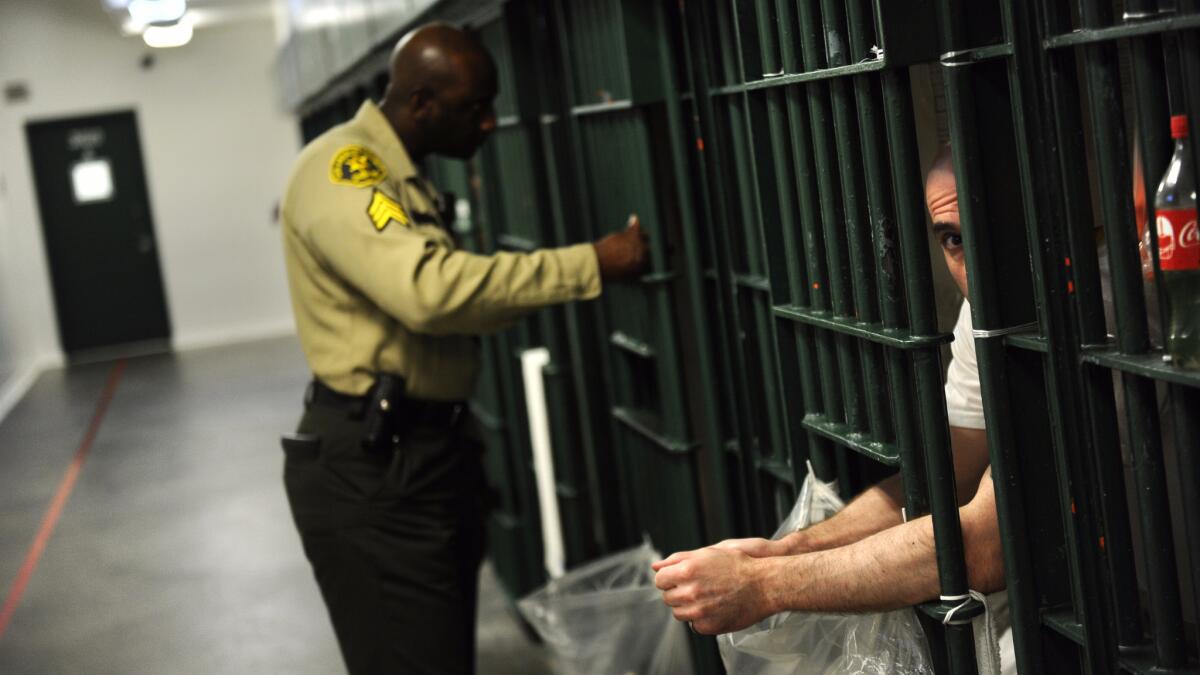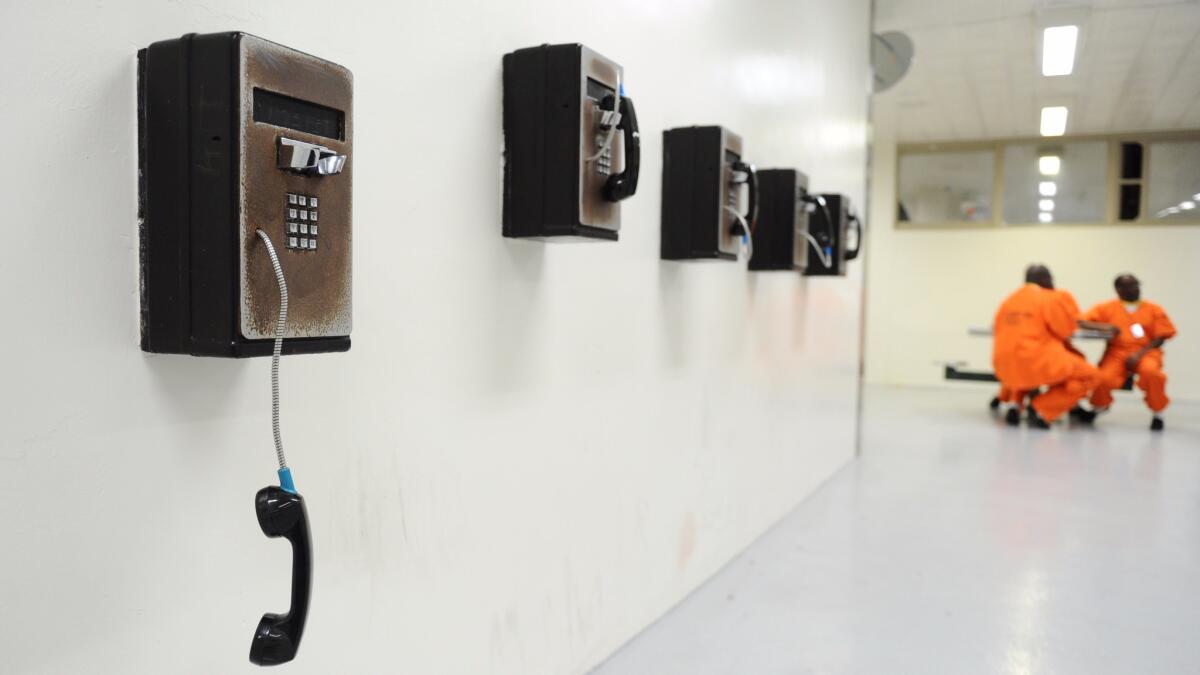No touching. No human contact. The hidden toll on jail inmates who spend months or years alone in a 7x9 foot cell

In nearly three years, Dominic Walker rarely looked another human being in the eye.
Except for showers, he left his cell at Men’s Central Jail in downtown Los Angeles only once a week, to exercise in a small cage resembling a dog kennel. His conversations were typically shouted through cell bars to other inmates in his row.
“It makes you feel like nobody. I’m here, the walls are closing in. It makes you hallucinate,” said Walker, 34, who was released in June after prosecutors dropped his armed robbery charge.
More than 300 inmates in the antiquated jail live in near-total solitude, deprived of meaningful human contact either because they have misbehaved behind bars or because officials believe they must be kept away from others for safety reasons. Another 100 or so, including women, are doing their time in solitary units — officially called restrictive housing — at jails elsewhere in the county.
Throughout the nation, state prisons have come under intense scrutiny because of concerns that inmates who are deprived of social contact in solitary confinement can suffer serious psychological damage. Last year, spurred by hunger strikes and a lawsuit, the California state prison system reduced the population of its Solitary Housing Unit by thousands of inmates, joining states such as Colorado, Mississippi, Maine and North Carolina that have made similar changes.
But long-term isolation in county lockups, where most inmates are awaiting trial or serving short sentences, has largely remained a hidden issue.
The majority of these inmates, they want to be out, to have the interaction, the freedom. It’s healthier.
— Capt. Joseph Dempsey
In Los Angeles County, the average stay in restrictive housing is more than a year — shorter than the decades that some state prisoners spent in solitary but still plenty of time to experience debilitating psychological effects, according to mental health experts. The symptoms, which include paranoia and hallucinations, can continue even after an inmate goes home.
“A silent damage of jail incarceration is that people spend time in solitary,” said Terry Kupers, a psychiatrist who is an expert on solitary confinement and has researched the treatment of mentally ill inmates in the L.A. County jails.
Late last year, sheriff’s officials embarked on a series of changes designed to reduce the solitary population and provide more social contact for those who remain, making L.A. County one of the few jail systems in the country to do so.
According to the officials, the conditions at Men’s Central Jail do not amount to true solitary confinement. The gaps between cell bars, they say, offer limited interaction with neighboring inmates, even if the men cannot see one other and must yell to be heard.
Still, they acknowledge that the shift is partly for humanitarian reasons and is in line with a general push to give inmates more time out of their cells and more access to educational classes. They cite an increasing national focus on the mental health effects of solitary confinement and a recognition that the tide is beginning to turn against the practice.
They also hope the jails will be easier to run when inmates have more interaction with others and face the threat of losing the privilege if they misbehave.
“The majority of these inmates, they want to be out, to have the interaction, the freedom. It’s healthier,” said Capt. Joseph Dempsey, who is in charge of Men’s Central Jail. “It makes them act better during the week, before they get it.”

On the 3000 floor of Men’s Central Jail on a recent day, a seven-by-nine foot cell was crammed with a bed, toilet, phone and a shelf filled with books, leaving barely enough room for a man to turn around.
Reading glasses and a Bible rested on a small table. A makeshift mirror, fashioned to help an inmate see who was coming down the narrow walkway, was perched on the green bars that fronted the cell.
Until recently, the tier was filled with the cacophony of men shouting to be heard above blaring television sets, which are mounted on the corridor walls and shared by several adjoining cells.
The decibel level decreased after the inmates received wireless earpieces to pipe in the TV audio and could speak to each other in quieter voices. Some also communicate using written notes, or kites, which are passed by extending an arm in front of a neighboring cell, using other inmates as messengers, or dangling a string weighted by a heavy object, such as a bar of soap.
Some of the 4,800-man jail’s most dangerous and disruptive inmates, including high-level gang leaders, live here in the restrictive housing unit, which is known informally as K-10, with the K standing for “keep-away.” Another term, “high-power,” also alludes to the threat jailers believe these inmates pose.
But not all K-10s are violent. Some live in isolation because they need to be protected from other inmates. This category includes celebrity inmates or those accused of high-profile crimes, like gangsta rap mogul Suge Knight and the Grim Sleeper serial killer.
The county’s euphemistic lexicon for solitary confinement has helped keep the issue out of the public eye, said Mark-Anthony Johnson, director of health and wellness for the jail reform group Dignity and Power Now.
“The way K-10 is talked about is, ‘We need to keep these people away from the population,’ and that’s where the conversation around their rights gets lost,” Johnson said.
Contrary to the assertions of sheriff’s officials, the conditions at Men’s Central Jail fit the definition of solitary confinement, according to some experts.
“We’re not talking truly about sensory deprivation but about meaningful, anchoring stimulation,” said Stuart Grassian, a psychiatrist who has served as an expert for plaintiffs in lawsuits opposing solitary confinement.
In a recent article in the Prison Journal, UC Santa Cruz psychologist Craig Haney called solitary confinement in local jails “among the least studied components of the entire criminal justice system.” Haney, who provided a scathing critique of solitary confinement in the California state prison lawsuit, cited a United Nations-appointed expert who contended that solitary confinement of more than 15 days can amount to torture.
As state prisons across the country have changed their practices to reflect mental health and human rights concerns, jails have been slow to follow.
In November 2015, the Prison Law Office sued on behalf of two Santa Clara County jail inmates in solitary confinement who allegedly were not taken outdoors for seven months.
One plaintiff, Brian Chavez, said he became easily irritated and preoccupied with fears of dying alone in his cell, the lawsuit said. The other plaintiff, Brandon Bracamonte, alleged he could no longer concentrate and became so anxious that he paced back and forth in his cell, hyper-vigilant to noises.
Donald Specter, the plaintiffs’ lead attorney, said he is negotiating a settlement with Santa Clara jail officials that he hopes will require improved conditions for inmates.
“Jails statewide need to take a look at this issue,” he said.
Jails statewide need to take a look at this issue.
— Donald Specter
In Texas, solitary confinement is widespread in jails, said Diana Claitor, executive director of the Texas Jail Project. Vulnerable inmates, such as those who are mentally ill or pregnant, are sometimes put into solitary as a quick fix, she said.
Rikers Island in New York City is among the few jails that has drastically reduced its use of solitary housing. Since a package of reforms was instituted in January 2015, the solitary population has dropped from over 500 to about 160.
**
Sitting at a round cafeteria table, the three middle-aged men conversed animatedly. Each had spent decades on death row before his conviction was overturned and he arrived at Men’s Central Jail to await a new trial.
Because of their common experiences, they would likely hit it off, jail officials decided.
Cleamon Johnson, 48, and Michael Allen, 43, were co-defendants in the 1991 homicides of two alleged gang rivals and had been back in the solitary unit for about four years. The third man, who would not give his name, was a 58-year-old from the Antelope Valley who was sentenced to death for a killing in 1998.
Before Johnson began gathering with the others once a week, he was not allowed to touch another human being — not even to shake hands, he said, grasping the hand of his goateed, bespectacled 58-year-old friend to demonstrate.
Johnson, whose street name was Big Evil and who is thought by authorities to have had a hand in more than 20 murders, made his first trip to the K-10 unit when he was 18. In those days, he said, “it made the wild, wild west look like Disneyland.”
“You couldn’t look them in the eye and have a conversation, as opposed to sitting at a table and having a decent dialogue,” said Johnson, who has a shaved head and an earnest expression. “K-10 was extremely chaotic. The only thing you could look forward to was participating in chaos.”
Now the three men spend their brief time together discussing world affairs and legal issues. They also attend classes on critical thinking and anger management. The long hours alone in their cells are easier to bear when there is something to break up the monotony.
Until recently, it was nearly impossible to get out of solitary: Once an inmate was classified a K-10, he remained a K-10, even on subsequent visits. Jail officials are now evaluating each inmate to see who might be ready to socialize with others. The small groups are carefully selected based on who is likely to get along.
In addition to congregating in day rooms every week or so, some inmates now do their exercise time with other inmates. They can choose from a small menu of educational classes and religious services.
Those who are prone to lashing out violently can be strapped into chairs so they can sit together in groups. More social interaction may calm troublemakers who used to act out by throwing feces or attacking people with homemade spears, sheriff’s officials said.
Since the recent changes, some former K-10s have been integrated into the general population, and the unit has shrunk from 450 inmates to roughly 350. About 200 or so K-10s have the weekly day room hours. The rest – 150 or so men — have as little human contact as traditional K-10s.
There have been only two major fights. One happened when some inmates in the exercise yard came to blows over whether pork is the other white meat.
“We had staff who were adamant: ‘They will kill each other. I’m not putting my name to it,’” said Deputy Barry Poltorak, who works on the new program. “But we see the benefits. Guys want it, are asking for it.”
NEWSLETTER: Get the day’s top headlines from Times Editor Davan Maharaj »
Esther Lim, the jails project director at the ACLU of Southern California, called the changes long overdue. The ACLU will be monitoring the Sheriff’s Department to make sure that the only inmates in solitary are those who genuinely need to be separated from others, she said.
For some, the limits on solitary confinement come too late. Aubrey Berry, who was found not guilty in 2010 of murdering a rapper at the Beverly Center, was never the same after spending a year in solitary at Men’s Central Jail, said his attorney, Howard Price.
Berry withdrew from family and friends — not a typical reaction for someone who has been exonerated, Price said.
“I have no doubt that the incarceration of Aubrey Berry altered him permanently for the rest of his life,” Price said. “He was always complaining about how the time passed so slowly. Every day was the same. There was nothing to think about or do.”
ALSO
Another kind of drought: Inmate fire crews dwindle as wildfire season grows ever longer
Illegal drugs are flowing into California’s most guarded prisons — and killing death row inmates
More to Read
Sign up for Essential California
The most important California stories and recommendations in your inbox every morning.
You may occasionally receive promotional content from the Los Angeles Times.











